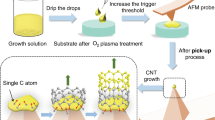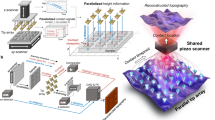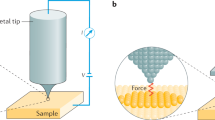Abstract
The development of atomic force microscopy (AFM) over the past 20 years has had a major impact on materials science, surface science and various areas of biology, and it is now a routine imaging tool for the structural characterization of surfaces. The lateral resolution in AFM is governed by the shape of the tip and the geometry of the apex at the end of the tip. Conventional microfabrication routes result in pyramid-shaped tips, and the radius of curvature at the apex is typically less than 10 nm. As well as producing smaller tips, AFM researchers want to develop tips that last longer, provide faithful representations of complex surface topographies, and are mechanically non-invasive. Carbon nanotubes have demonstrated considerable potential as AFM tips but they are still not widely adopted. This review traces the history of carbon nanotube tips for AFM, the applications of these tips and research to improve their performance.
This is a preview of subscription content, access via your institution
Access options
Subscribe to this journal
Receive 12 print issues and online access
$259.00 per year
only $21.58 per issue
Buy this article
- Purchase on Springer Link
- Instant access to full article PDF
Prices may be subject to local taxes which are calculated during checkout






Similar content being viewed by others
References
Wood, J. The top ten advances in materials science. Mater. Today 11, 40 (2008).
Wiesendanger, R. Scanning Probe Microscopy and Spectroscopy (Cambridge Univ. Press, 1994).
Ximen, H. & Russell, P. E. Microfabrication of AFM tips using focused ion and electron beam techniques. Ultramicroscopy 42–44, 1526–1532 (1992).
Saito, R., Dresselhaus, G. & Dresselhaus, M. S. Physical Properties of Carbon Nanotubes (Imperial College Press, 1998).
Dai, H. et al. Nanotubes as nanoprobes in scanning probe microscopy. Nature 384, 147–150 (1996).
Binnig, G., Quate, C. F. & Gerber, Ch. Atomic force microscope. Phys. Rev. Lett. 56, 930–933 (1986).
Albrecht, T. R., Akamine, S., Carver, T. E. & Quate, C. F. Microfabrication of cantilever styli for the atomic force microscope. J. Vac. Sci. Technol. A 8, 3386–3396 (1990).
Nguyen, C. V., Ye, Q. & Meyyappan, M. Carbon nanotube tips for scanning probe microscopy: fabrication and high aspect ratio nanometrology. Meas. Sci. Technol. 16, 2138–2146 (2005).
Wong, E. W., Sheehan, P. E. & Lieber, C. M. Nanobeam mechanics: Elasticity, strength, and toughness of nanorods and nanotubes. Science 277, 1971–1975 (1997).
deJonge, N., Lamy, Y. & Kaiser, M. Controlled mounting of individual multiwalled carbon nanotubes on support tips. Nano Lett. 3, 1621–1624 (2003).
Martinez, J. et al. Length control and sharpening of atomic force microscope carbon nanotube tips assisted by an electron beam. Nanotechnology 16, 2493–2496 (2005).
Kim, D.-H. et al. Shortening multiwalled carbon nanotube on atomic force microscope tip: Experiments and two possible mechanisms. J. Appl. Phys. 101, 064317 (2007).
Jiang, A. N. et al. Amplitude response of multiwalled carbon nanotube probe with controlled length during tapping mode atomic force microscopy. J. Phys. Chem. C 112, 15631–15636 (2008).
Nishijima, H. et al. Carbon-nanotube tips for scanning probe microscopy: Preparation by a controlled process and observation of deoxyribonucleic acid. Appl. Phys. Lett. 74, 4061–4063 (1999).
Kong, J. et al. Synthesis of individual single-walled carbon nanotubes on patterned silicon wafers. Nature 395, 878–881 (1998).
Kong, J., Cassell, A. M. & Dai, H. Chemical vapor deposition of methane for single-walled carbon nanotubes. Chem. Phys. Lett. 292, 567–574 (1998).
Hafner, J. H. et al. Catalytic growth of single-wall carbon nanotubes from metal particles. Chem. Phys. Lett. 296, 195–202 (1998).
Hafner, J. H., Cheung, C. L. & Lieber, C. M. Growth of nanotubes for probe microscopy tips. Nature 398, 761–762 (1999).
Hafner, J. H., Cheung, C. L. & Lieber, C. M. Direct growth of single-walled carbon nanotube scanning probe microscopy tips. J. Am. Chem. Soc. 121, 9750–9751 (1999).
Yenilmez, E. et al. Wafer scale production of carbon nanotube scanning probe tips for atomic force microscopy. Appl. Phys. Lett. 80, 2225–2227 (2002).
Hafner, J. H., Cheung, C. L. Oosterkamp, T. H. & Lieber, C. M., High-yield assembly of individual single-walled carbon nanotube tips for scanning probe microscopies. J. Phys. Chem. B 105, 743–746 (2001).
Zhang, Y. et al. Electric-field-directed growth of aligned single-walled carbon nanotubes. Appl. Phys. Lett. 79, 3155–3157 (2001).
Ren, Z. F. et al. Growth of a single freestanding multiwall carbon nanotube on each nanonickel dot. Appl. Phys. Lett. 75, 1086–1088 (1999).
Ye, Q. et al. Large-scale fabrication of carbon nanotube probe tips for atomic force microscopy critical dimension imaging applications. Nano Lett. 4, 1301–1308 (2004).
Girifalco, L. A., Hodak, M. & Lee, R. S. Carbon nanotubes, buckyballs, ropes, and a universal graphitic potential. Phys. Rev. B 62, 13104–13110 (2000).
Salvetat, J.-P. et al. Elastic and shear moduli of single-walled carbon nanotube ropes. Phys. Rev. Lett. 82, 944–947 (1999).
Wilson, N. R., Cobden, D. H. & Macpherson, J. V. Single-wall carbon nanotube conducting probe tips. J. Phys. Chem. B 106, 13102–13105 (2002).
Tayebi. N. et al. Nanopencil as a wear-tolerant probe for ultrahigh density storage. Appl. Phys. Lett. 93, 103112 (2008).
Carnally, S. et al. Ultra-resolution imaging of a self-assembling biomolecular system using robust carbon nanotube AFM probes. Langmuir 23, 3906–3911 (2007).
Snow, E. S., Campbell, P. M. & Novak, J. P. Atomic force microscopy using single-wall C nanotube probes. J. Vac. Sci. Technol. B 20, 822–827 (2002).
Lin, Y. et al. Advances toward bioapplications of carbon nanotubes. J. Mater. Chem. 14, 527–541 (2004).
Strano, M. S. et al. Electronic structure control of single-walled carbon nanotubes functionalization. Science 301, 1519–1522 (2003).
Zheng, M. et al. DNA-assisted dispersion and separation of carbon nanotubes. Nature Mater. 2, 338–342 (2003).
Zheng, M. et al. Structure-based carbon nanotube sorting by sequence-dependent DNA assembly. Science 302, 1545–1548 (2003).
Keren, K. et al. DNA-templated carbon nanotube field-effect transistor. Science 302, 1380–1382 (2003).
Tang, J. et al. Rapid and reproducible fabrication of carbon nanotube AFM probes by dielectrophoresis. Nano Lett. 5, 11–14 (2005).
Kim, J. E., Park, J. K. & Han, C. S. Use of dielectrophoresis in the fabrication of an atomic force microscope tip with a carbon nanotube: experimental investigation. Nanotechnology 17, 2937–2941 (2006).
Wilson, N. R. & Macpherson, J. V. Single-walled carbon nanotubes as templates for nanowire conducting probes. Nano Lett. 3, 1365–1369 (2003).
Ishikawa, K. & Cho, Y. Using an electroconductive carbon nanotube probe tip in scanning nonlinear dielectric microscopy. Rev. Sci. Instrum. 77, 103708 (2006).
Zhao, M. et al. Ultrasharp and high aspect ratio carbon nanotube atomic force microscopy probes for enhanced surface potential imaging. Nanotechnology 19, 235704 (2008).
Deng, Z. F. et al. Metal-coated carbon nanotube tips for magnetic force microscopy. Appl. Phys. Lett. 85, 6263–6265 (2004).
Winkler, A. et al. Magnetic force microscopy sensors using iron-filled carbon nanotubes. J. Appl. Phys. 99, 104905 (2006).
Burt, D. P. et al. Nanowire probes for high resolution combined scanning electrochemical microscopy — Atomic force microscopy. Nano Lett. 5, 639–643 (2005).
Wong, S. S., Woolley, A. T., Joselevich, E. & Lieber, C. M. Functionalization of carbon nanotube AFM probes using tip-activated gases. Chem. Phys. Lett. 306, 219–225 (1999).
Wong, S. S. et al. Covalently functionalized nanotubes as nanometre-sized probes in chemistry and biology. Nature 394, 52–55 (1998).
Chen, X., Kis, A., Zettl, A. & Bertozzi, C. R. A cell nanoinjector based on carbon nanotubes. Proc. Natl Acad. Sci. USA 104, 8218–8222 (2007).
Chen, L., Cheung, C. L., Ashby, P. D. & Lieber, C. M. Single-walled carbon nanotube AFM probes: Optimal imaging resolution of nanoclusters and biomolecules in ambient and fluid environments. Nano Lett. 4, 1725–1731 (2004).
Li, Y. et al. Controlled assembly of dendrimer-like DNA. Nature Mater. 3, 38–42 (2004).
Woolley, A. T., Cheung, C. L., Hafner, J. H. & Lieber, C. M. Structural biology with carbon nanotube AFM probes. Chem. Biol. 7, R193–R204 (2000).
Chen. L., Haushalter, K. A., Lieber, C. M. & Verdine, G. L. Direct visualization of a DNA glycosylase searching for damage. Chem. Biol. 9, 345–350 (2002).
Wong, S. S. et al. Single-walled carbon nanotube probes for high-resolution nanostructure imaging. Appl. Phys. Lett. 73, 3465–3467 (1998).
Cheung, C. L., Hafner, J. H. & Lieber, C. M. Carbon nanotube atomic force microscopy tips: Direct growth by chemical vapor deposition and application to high-resolution imaging. Proc. Natl Acad. Sci. USA 97, 3809–3813 (2000).
Harper, J. D., Wong, S. S., Lieber, C. M. & Lansbury, P. T. Assembly of A beta amyloid protofibrils: An in vitro model for a possible early event in Alzheimer's disease. Biochemistry 38, 8972–8980 (1999).
Moloni, K., Buss, M. R. & Andres, R. P. Tapping mode scanning force microscopy in water using a carbon nanotube probe. Ultramicroscopy 80, 237–246 (1999).
Jarvis, S. P. et al. Local solvation shell measurement in water using a carbon nanotube probe. J. Phys. Chem. B 104, 6091–6094 (2000).
Stevens, R. M., Nguyen, C. V. & Meyyappan, M. Carbon nanotube scanning probe for imaging in aqueous environment. IEEE Trans. Nanobiosci. 3, 56–60 (2004).
Larsen, T. et al. Comparison of wear characteristics of etched-silicon and carbon nanotube atomic-force microscopy probes. Appl. Phys. Lett. 80, 1996–1998 (2002).
Nguyen, C. et al. Carbon nanotube tip probes: stability and lateral resolution in scanning probe microscopy and applications to surface science in semiconductors. Nanotechnology 12, 363–367 (2001).
Wade, L. A. et al. Correlating AFM probe morphology to image resolution for single-wall carbon nanotube tips. Nano Lett. 4, 725–731 (2004).
Nguyen, C. V. et al. Carbon nanotube scanning probe for profiling of deep-ultraviolet and 193 nm photoresist patterns. Appl. Phys. Lett. 81, 901–903 (2002).
Stevens, R. et al. Improved fabrication approach for carbon nanotube probe devices. Appl. Phys. Lett. 77, 3453–3455 (2000).
Solares, S. D. Characterization of deep nanoscale surface trenches with AFM using thin carbon nanotube probes in amplitude modulation and frequency-force-modulation modes. Meas. Sci. Technol. 19, 015503 (2008).
Kutana, A., Giapis, K. P., Chen, J. Y. & Collier, C. P. Amplitude response of single-wall carbon nanotube probes during tapping mode atomic force microscopy: Modeling and experiment. Nano Lett. 6, 1669–1673 (2006).
Solares, S. D., Esplandiu, M. J., Goddard, W. A. & Collier, C. P. Mechanism of single walled carbon nanotube probe sample multistability in tapping mode AFM imaging. J. Phys. Chem. B 109, 11493–11500 (2005).
Shapiro, I. R. et al. Influence of elastic deformation on single-wall carbon nanotube atomic force microscopy probe resolution. J. Phys. Chem. B 108, 13613–13618 (2004).
Solares, S. D., Matsuda, Y. & Goddard, W. A. Influence of the carbon nanotube probe tilt angle on the effective probe stiffness and image quality in tapping-mode atomic force microscopy. J. Phys. Chem. B 109, 16658–16664 (2005).
Ishikawa, K., Honda, K. & Yasuo. C. Resolution enhancement in contact-type scanning nonlinear dielectric microscopy using a conductive carbon nanotube probe tip. Nanotechnology 18, 084015 (2007).
Martin, Y., Abraham, D. W. & Wickramasinghe, H. K. High-resolution capacitance measurement and potentiometry by force microscopy. Appl. Phys. Lett. 52, 1103–1105 (1988).
Wilson, N. R. & Macpherson, J. V., Enhanced resolution electric force microscopy with single-wall carbon nanotube tips. J. Appl. Phys. 96, 3565–3567 (2004).
Arnason, S. B., Rinzler, A. G., Hudspeth, Q. & Hebard, A. F. Carbon nanotube-modified cantilevers for improved spatial resolution in electrostatic force microscopy. Appl. Phys. Lett. 75, 2842–2844 (1999).
Arie, T. Nishijima, H., Akita, S. & Nakayama, Y. Carbon-nanotube probe equipped magnetic force microscope. J. Vac. Sci. Tech. B 18, 104–106 (2000).
Kalinin, S. & Gruverman, A. Scanning Probe Microscopy Electrical and Electrochemical Phenomena at the Nanoscale: Fundamentals and Applications (Springer, 2007).
Tseng, A. A., Notargiacomo, A. & Chen, T. P. Nanofabrication by scanning probe microscope lithography: A review. J. Vac. Sci. Technol. B 23, 877–894 (2005).
Cooper, E. B. et al. Tetrabit-per-square-inch data storage with the atomic force microscope. Appl. Phys. Lett. 75, 3566–3568 (1999).
Austin, A. J. & Nguyen, C. Electrical conduction of carbon nanotube atomic force microscopy tips: Application in nanofabrication. J. Appl. Phys. 99, 114304 (2006).
Kuramochi, H., Tokizaki, T., Yokoyama, H & Dagata, J. A. Why nano-oxidation with carbon nanotube probes is so stable: I. Linkage between hydrophobicity and stability. Nanotechnology 18, 135703 (2007).
Dai, H., Franklin, N. & Han, J. Exploiting the properties of carbon nanotubes for lithography. Appl. Phys. Lett. 73, 1508–1510 (1998).
Jian, S.-R. & Juang, J.-Y. Scanned probe oxidation of p-GaAs(100) surface with an atomic force microscopy. Nanoscale Res. Lett. 3, 249–254 (2008).
Kuramochi, H. et al. Nano-oxidation and in situ faradaic current detection using dynamic carbon nanotube probes. Nanotechnology 15, 1126–1130 (2004).
Park, J. G., Zhang, C., Liang, R. & Wang, B. Nano-machining of highly orientated pyrolytic graphite using conductive atomic force microscope tips and carbon nanotubes. Nanotechnology 18, 405306 (2007).
Gotoh, Y., Matsumoto, K. & Maeda, T. Room temperature coulomb diamond characteristic of single electron. Transistor made by AFM nano-oxidation process. Jpn J. Appl. Phys. 41, 2578–2582 (2002).
Noy, A. Chemical force microscopy of chemical and biological interactions. Surf. Interf. Anal. 38, 1429–1441 (2006).
Vakarelski, I. U., Brown, S. C., Higashitani, K. & Moudgil, B. M. Penetration of living cell membranes with fortified carbon nanotube tips. Langmuir 23, 10893–10896 (2007).
Gardner, C. E. & Macpherson, J. V. Atomic force microscopy probes go electrochemical. Anal. Chem. 74, 576A–584A (2002).
Patil, A., Sippel, J., Martin, G. W. & Rinzler, A. G. Enhanced functionality of nanotube atomic force microscopy tips by polymer coating. Nano Lett. 4, 303–308 (2004).
Esplandiu, M. J., Bittner, V. G., Giapis, K. P. & Collier, C. P. Nanoelectrode scanning probes from fluorocarbon-coated single-walled carbon nanotubes. Nano Lett. 4, 1873–1879 (2004).
Narui, Y., Ceres, D. M., Chen, J., Giapis, K. P. & Collier, C. P. High aspect ratio silicon dioxide coated single walled carbon nanotube scanning probe nanoelectrodes, J. Phys. Chem. C 113, 6815–6820 (2009).
Burt. et al. Developments in nanowire scanning electrochemical atomic force microscopy (SECM-AFM) probes. IEEE Sensors 1–3, 712–715 (2007).
Wilson, N. R. Electronic Transport in Single Walled Carbon Nanotubes and Their Application as Scanning Probe Microscopy Tips. PhD Thesis, Univ. Warwick (2004).
Jaroenapibal, P., Luzzi, D. E., Evoy, S. & Arepalli, S. Transmission-electron-microscopic studies of mechanical properties of single-walled carbon nanotube bundles. Appl. Phys. Lett. 85, 4328–4330 (2004).
Valcarcel, V., Cardenas, S. & Simonet, B. M. Role of carbon nanotubes in analytical science. Anal. Chem. 79, 4788–4797 (2007).
Author information
Authors and Affiliations
Corresponding author
Rights and permissions
About this article
Cite this article
Wilson, N., Macpherson, J. Carbon nanotube tips for atomic force microscopy. Nature Nanotech 4, 483–491 (2009). https://doi.org/10.1038/nnano.2009.154
Published:
Issue Date:
DOI: https://doi.org/10.1038/nnano.2009.154
This article is cited by
-
Investigating the atomic behavior of carbon nanotubes as nanopumps
Scientific Reports (2023)
-
Scanning probe microscopy
Nature Reviews Methods Primers (2021)
-
Epitaxial pyrolytic carbon coatings templated with defective carbon nanotube cores for structural annealing and tensile property improvement
Journal of Materials Science (2021)
-
Current Situation and Prospect of Nanometrology and its Standardization in Indonesia
MAPAN (2018)
-
Robust rotation of rotor in a thermally driven nanomotor
Scientific Reports (2017)



